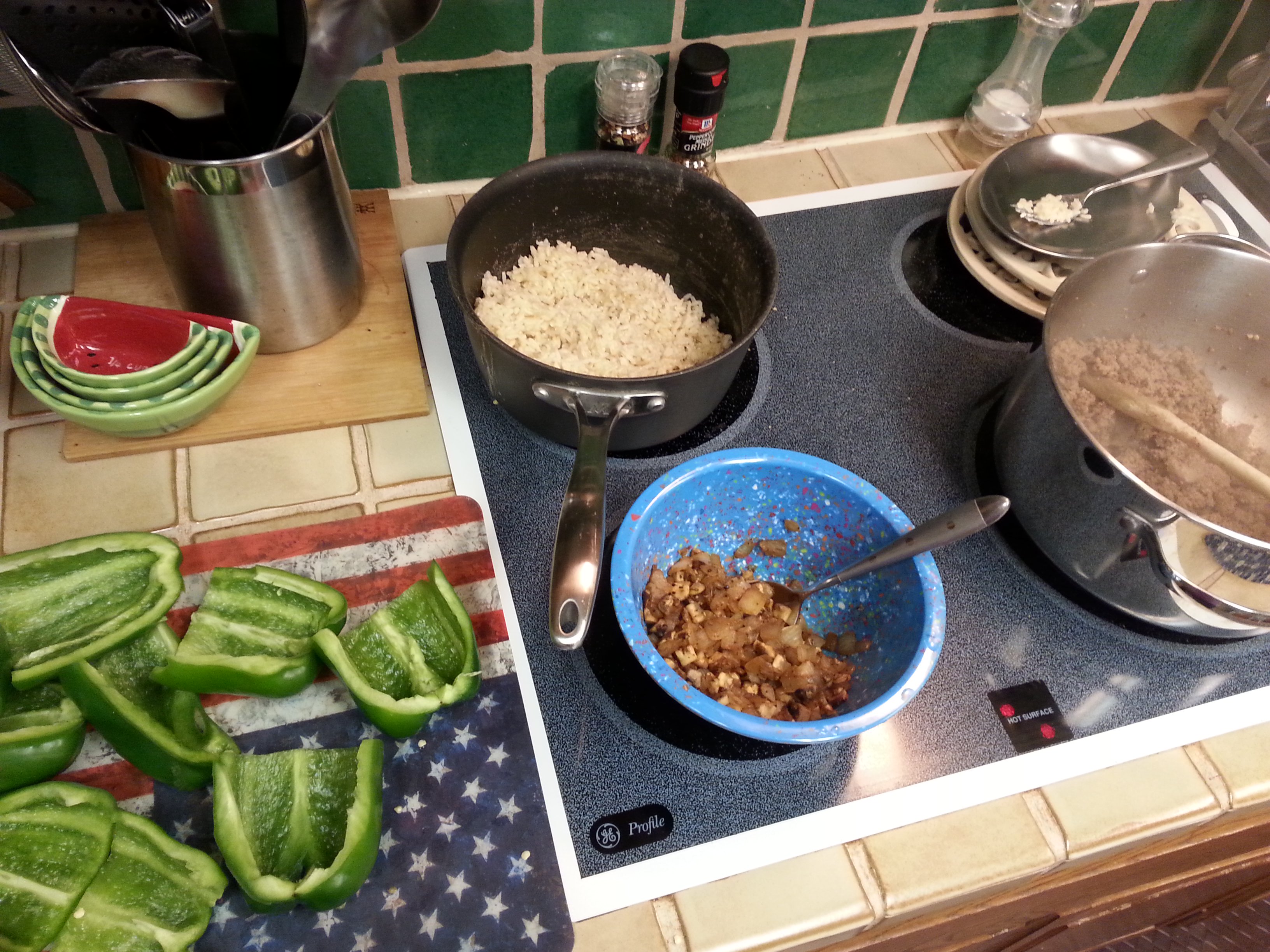Cooking for One
Author: Massage Heights
Massage Heights’ philosophy has evolved into much more than providing therapeutic services, it’s about being part of a larger wellness movement focused on helping people achieve balanced and healthy lifestyles. Enjoy this month's blog from our nutrition contributor, Shannon!
Cooking for One
By: Shannon A. Garcia, Registered Dietitian, Owner of Lone Star Nutrition, LLC
Here lately I’ve noticed an increase in questions and comments about the struggle with cooking for only one or two people. Usually the question comes after a comment about a negative experience – example, “Cooking for one is impossible - I tried a few months ago and made 5 pounds of meat because I wanted tacos. After that experience, I’m sticking with Chipotle”. True story. So for all of you struggling to prepare food for one or two, this blog is for you. Hopefully after reading this, you will be more inspired, less intimidated and ready to conquer the mindset “cooking for one or two people is just too hard.”
The why
First things first - decide preparing more meals at home is worth it. Realize the time spent at the grocery store and in your kitchen is time you won’t spend in a drive-thru. Time you won’t spend texting your friend or partner “Where do you want to eat” “It doesn’t matter” “Well you picked last time” “I always pick”. Conversation sound familiar? Instead, you could say “I made dinner, would you like to join me?. Maybe you’ll even spend less time at the gym attempting to compensate for last night’s pizza and wine fest, because after all, abs are made in the kitchen - whether we like it or not. Please note, I’m not suggesting spending less time on physical fitness or compensating for poor eating habits - an optimal goal is regular exercise and a balanced diet, without feeling the need to over-exercise because of an over-indulgence.
Perhaps even more significant is the long-term benefit of healthy meals and their impact on overall health. Better health can mean less time spent at a doctor’s office, less money spent on medications and more quality of life - now and later. You get the picture - there are countless reasons why preparing healthy food at home is beneficial; figure out what motivates you and decide that this is happening.
The How
Cooking for yourself or two people still requires some planning and prep work. You could whip up a “smaller” meal every night, but that’s exactly what we’re trying to avoid, right? Creating a menu of one to three meals for the week (based on what’s realistic with your household and schedule), purchasing those items and preparing certain components of the meal ahead of time will make weeknight meals a breeze. Sound intriguing? Keep reading.
The When
Identifying your ideal time for both grocery shopping and meal preparation is key.
For most folks, this is usually a weekend when lists are created, items are purchased and then prepped on a Sunday. However, the weekend is not key to your success if your schedule dictates otherwise. If you’re a student or maybe travel a portion of the week, designate your meal prep day accordingly. Structure is key! Pick a few recipes, create a list and allow yourself a reasonable amount of time at the store (an hour or less) followed by another one to two hours of meal prep. Total time will likely be anywhere from 2-4 hours, but well worth it in the days to come when you’re enjoying a meal, shortly after walking in the door from a long day at work.
The What and the How Much
 If using a recipe, you know the specific items to purchase and prepare. Nowadays, many websites with recipes feature calculators that will allow you to divide or multiply a recipe to determine the appropriate ingredient measurements. If not using a recipe, consider making batches of the following:
If using a recipe, you know the specific items to purchase and prepare. Nowadays, many websites with recipes feature calculators that will allow you to divide or multiply a recipe to determine the appropriate ingredient measurements. If not using a recipe, consider making batches of the following:
Grains: Choose a grain like brown rice, faro, quinoa, hard wheat berries or a whole wheat pasta. Grain servings should range between a ½ cup and 1 cup per person at meals depending on your specific dietary needs. For one person, consider preparing 2-3 cups of grains (cooked amount) for the week.
Vegetables: Most veggies can be steamed or baked days in advance and still stay fresh. Aim for a minimum of one cup of cooked vegetables at all meals, but less is not more with veggies! Tonight, I made a spicy veggie spaghetti, and basically put in everything but the kitchen sink from my produce drawer. Also consider purchasing frozen vegetables to not compromise nutrition and eliminate concern for prepping vegetables soon after purchase.
 Protein: Consider the crockpot for making large batches of protein. Protein serving sizes vary among adults, but most will consume about the size of their palm or a deck of cards (3-4oz per meal). If you have an indoor grill, cook chicken breasts quickly and store individually in the fridge. Roast a pork loin in the oven, but store it whole in the fridge then sliced as needed to keep it from drying out.
Protein: Consider the crockpot for making large batches of protein. Protein serving sizes vary among adults, but most will consume about the size of their palm or a deck of cards (3-4oz per meal). If you have an indoor grill, cook chicken breasts quickly and store individually in the fridge. Roast a pork loin in the oven, but store it whole in the fridge then sliced as needed to keep it from drying out.
Put it all together: Whether separated on a plate or mixed together (stir-fry anyone?), whole grains + veggies + protein equals a balanced meal. Add different spices and lower calorie condiments (balsamic vinegar, Dijon mustard, reduced-fat dressings, etc.) to help switch up the flavor from night to night.
If you’re the kind of person who doesn’t mind eating the same meals several nights in a row, prepare a recipe you know will freeze well, reheat well and have all of the above mentioned components of a healthy meal. One of my personal favorite recipes to meal prep is stuffed peppers.
Extra tips:
- If purchasing a large package of meat, separate into single servings and repackage with label and date in your freezer.
- Check out the bulk section at your local grocery store to allow for smaller purchases of grains and spices - consider buying a small amount of something new every time you go grocery shopping.
- Use a muffin tin to store frozen rice or other grains - pop out from the muffin tin and store in freezer bags; reheat as needed.
- Don’t cut your recipe in half - make the full recipe but immediately freeze half into single or double serving portions. A homemade “frozen meal” beats a store bought one any day of the week.
- Consider protein sources that can be fixed quickly such as eggs or canned beans. Both eggs and a ½ cup of beans have approximately 7g protein each. And who doesn’t love breakfast for dinner? But don’t forget to add a veggie. Or three.
- Organize a meal swap exchange. Prepare several containers of one dish and swap with others. Not only will you try something new, but you’ll benefit from the accountability of a group also committed to making more nutritious meals at home.
- Keep healthy pantry and refrigerator staples in stock around the house to cut down on time the store and increase your ability to whip up a meal on the fly.
To end on an incredibly positive note, an arguable benefit to cooking for only one is not worrying about what anyone else wants to eat. Breakfast for dinner - why not? In the mood for maybe a heavy appetizer and not a full-blown dinner - go for it. I can guarantee you there’s countless folks short order cooking for the family, and would be envious of those only cooking to please and nourish themself. Treat yourself to some meals at home this week!